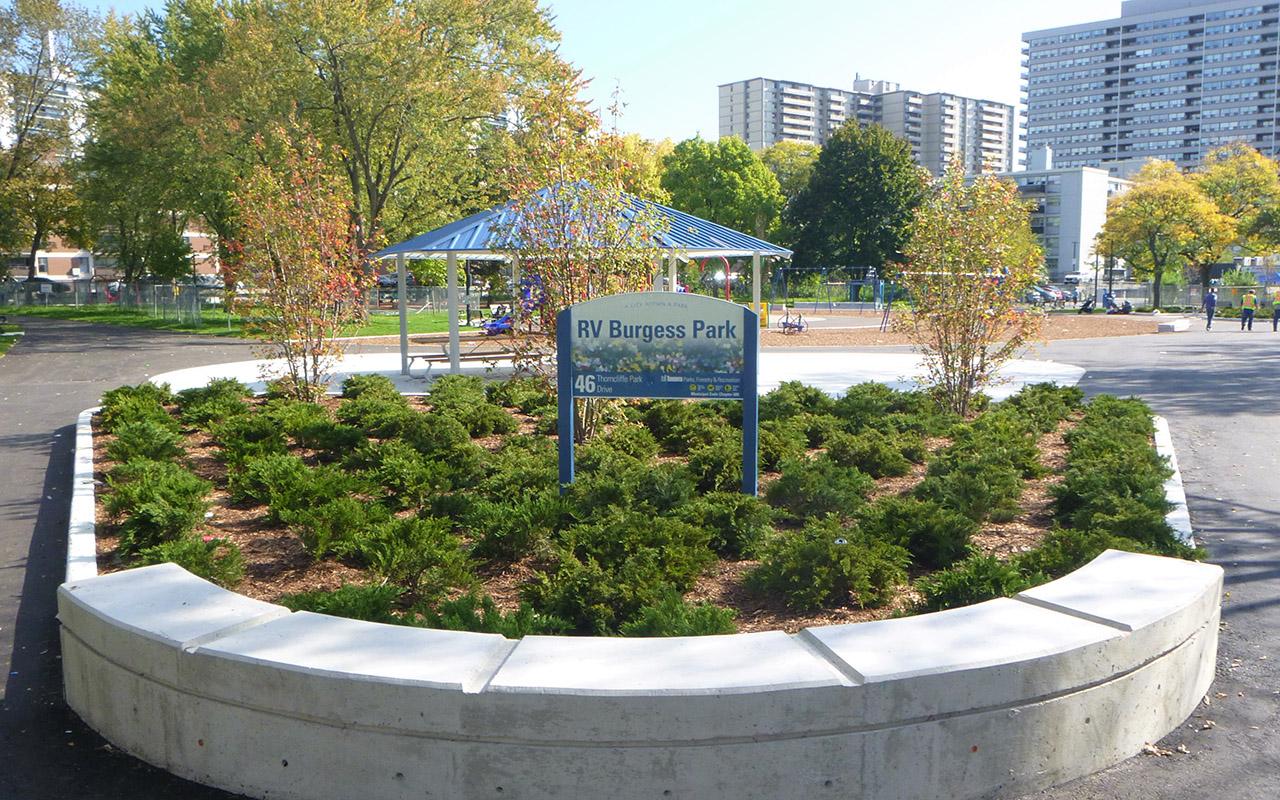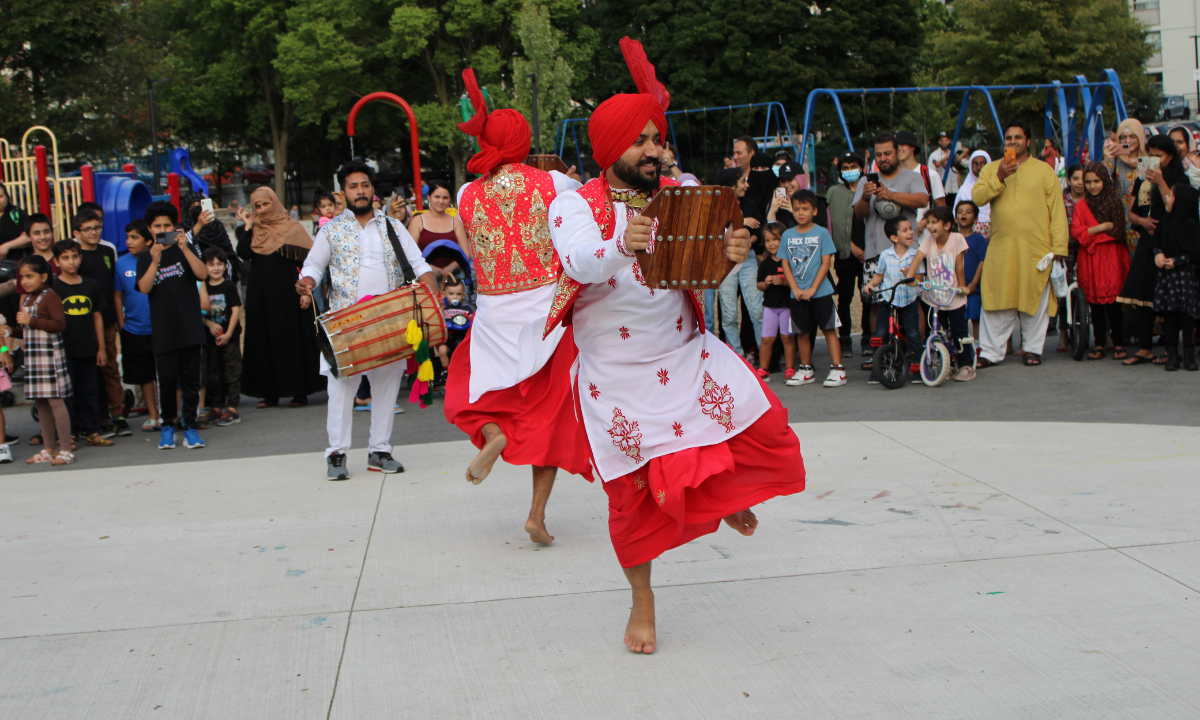Toronto non-profits meeting in parks, shopping malls as rental space becomes unaffordable
Why It Matters
Not having a permanent space in the neighbourhoods they serve further marginalizes Toronto's vulnerable communities and threatens to close down vital programming.

The group that has worked for 15 years to revitalize R.V. Burgess Park in Toronto says they are forced to meet outside there as they can’t afford a permanent space nearby.
“When the weather is nice, we have all our meetings in the park,” laughs Sabina Ali, Thorncliffe Park Women’s Committee executive director.
R.V. Burgess Park is in the Thorncliffe Park neighbourhood, a diverse and densely-populated area in northeast Toronto that cherishes the revitalized park.
The park now has new playground equipment, a park cafe, an outdoor tandoor oven, and an annual winter carnival, all thanks to the work of the Thorncliffe Park Women’s Committee.
The grassroots non-profit organization has worked to revitalize this underused outdoor space since 2008, yet the group doesn’t have a fixed address because it can’t afford one.
Ali isn’t alone in her struggle to find an affordable space to run her organization.

Last month, the Toronto Non-Profit Network launched a spatial justice campaign to raise awareness about the issue of disappearing community space in the city.
According to the network, a 2022 survey found that most non-profits said their biggest challenge was securing affordable and suitable space for operations.
“This comes at a time when they also have a rising demand for their services,” the network said in its campaign.
As more developers snap up properties to build condos, more grassroots organizers get pushed out of spaces they work and live in.
“Charities and non-profits and community groups want to be close to a subway station or on a main thoroughfare where people can find them,” said Bill Sinclair, executive director of The Neighbourhood Group Community Services, a non-profit in Toronto that provides social services such as childcare and elder care.
“Increasingly, those are places that are being torn down to build housing, which is also great, but it means that there’s no place for community services.”

The Neighbourhood Group has 34 locations across Toronto. Of those locations, the organization owns seven; some are expensive commercial leases, and others are below-market rent partnerships with churches, schools and the city.
One of the group’s leases is in a property listed for sale, putting that specific program at risk of not having a home soon, said Sinclair.
“I’m with a large human services organization, and we actually own some of our own buildings and even still, it’s a struggle,” Sinclair said.
The problem is even worse for smaller organizations, he added.
For older organizations like Toronto Neighbourhood Group, reputation and legacy play a significant role in accessing space for below-market rent.
“New groups coming to Canada today don’t have access. They haven’t had time to develop these kinds of relationships. And they are going to be missing out on space… some of the things we were able to do 20 years ago aren’t even possible to do now,” Sinclair said.
Opportunities for cheap leases from the city, as low as $1 per year, that was once a common way for municipalities to help non-profits is unheard of now.
“We often work with groups who aren’t incorporated because if you’re not incorporated, you’re not allowed to get permits. So you need to piggyback you need to partner up or have a trustee who can get permits,” Sinclair added.
Thorncliffe Park’s population grows as community space shrinks
Omar Khan is an organizer and advocate who works with community groups and marginalized communities in Thorncliffe Park.
Nearly 80 per cent of Thorncliffe Park’s residents are visible minorities, almost 50 per cent are South Asian, and most of them are immigrants. The low-income neighbourhood is also home to many children.
Khan coordinates a youth-focused group called Engage Communities that addresses growing issues with youth crime in the neighbourhood by creating recreational programs and opportunities for youth.
He said hunting for affordable space is the most time-consuming task for his unincorporated grassroots group.
Recently, Khan tried to find space to run a youth theatre workshop on Saturday afternoons.
His group couldn’t afford to rent school space because the province cut grants that make permits to use school property affordable. The nearby mall was also not an option.
“It’s very frustrating as we’ll see some vacant spaces in the mall, amazing, we could use that. But at the same time, we don’t have the money.”
Khan’s group secured a space at the last minute with the help of another neighbourhood organization. Still, he said the city needs to address the lack of affordable community space available to non-profits.
He said taxing vacant commercial space and offering tax breaks to landlords who rent to non-profits for below-market rent could create a win-win situation for empty storefronts and non-profits across the city.

Ali can relate. The group has done a lot of work to fix up R.V. Burgess Park for the community but doesn’t have a permanent office for meetings and storage.
The women’s committee organizes community gardens, markets, activities for youth and runs the Park Cafe, where women in the neighbourhood can gain work experience and learn employable skills.
“People used to just walk through the park to go to the mall on the other side, otherwise, it was not being used,” Ali said of the park’s state in 2008.
The playground equipment and many streetlights were broken, she said, calling it a shame to see how underused this coveted open space amidst a sea of highrise towers.
“So the concrete buildings we have means people don’t have access to backyards. We also really wanted people to use R.V. Burgess Park as their backyard,” Ali said.
Now, she says dozens of grassroots groups are working to improve conditions for newcomers in the neighbourhood. But more groups mean more competition for little communal space.
The few spaces available to rent are hard to access, said Ali.
Having a permanent office space would help keep the committee organized, she said but added she doesn’t worry too much because she likes maintaining the group’s “true grassroots approach.
“Once you do more, then funding comes in, then you have to do a lot of work and you just get lost,” Ali said.
The neighbourhood community centre and public library are inadequately small for the area’s population, Khan noted.
Development fees disappear as space becomes more scarce
The Toronto Non-Profit Network’s spatial justice campaign included several requests from the city, community space in mind when approving new developments.
“The city used to collect development fees and things like that to help pay for schools and parks and rec centers, and they can’t even get that anymore. So there’s really even fewer tools,” Sinclair said.
In 2022, the provincial government passed Bill 23, More Homes Built Faster Act, which lowered or removed fees paid to municipalities by developers to build housing more quickly.
“If you’re building housing and there’s going to be 200 people living here, who’s going to provide the childcare, who’s going to provide the elder care, who’s going to provide sports facilities for people, and how do you keep the other community user space in mind?” Sinclair asked.

Communities must be designed at the neighbourhood level, new developments must be mixed-use, and affordable space must be available for non-profits to offer services and run programs for those residents, said Khan.
He points to the many new residential and infrastructure developments planned for the Thorncliffe Park neighbourhood, including a Metrolinx railyard to accommodate the new Ontario Line subway track.
“In all those plans, I haven’t seen anything that says this amount of it will be mixed-use development for community, or there will be a huge community centre, or there will be huge community spaces for community to use. It’s not in there,” Khan said.
He is not the only one frustrated with plans for the neighbourhood. The province plans to move the Ontario Science Centre out of Thorncliffe Park and put it at Ontario Place, taking away one of the only recreational hubs this low-income community can access.
Ahmed Hussein, CEO of The Neighborhood Organization, told CBC News last year that newcomers, youth and people living on lower incomes in the area benefitted from the centre’s proximity.
The neighbourhood sorely needs more community space, not less, said Khan.
“If you’re going to move it, which would be a shame, then what will go in its place?” he said of the Ontario Science Centre.
The Toronto Non-Profit Network’s spatial justice campaign has ended, but the network’s work to advocate for more affordable community space continues.
According to the network, Toronto is home to more than 14,000 non-profits, with 105,000 full-time and 100,000 part-time workers, while volunteers contribute more than 1.7 billion hours annually.
Though City of Toronto investments account for only seven per cent of their total revenue, non-profits generate more than eight per cent of the city’s GDP, the network says.


